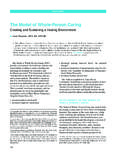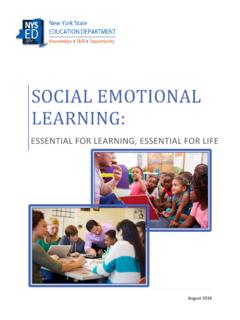Transcription of A whole school framework for emotional well-being and ...
1 Partnership for well -being and Mental Health in Schools A whole school framework for emotional well -being and mental health Supporting resources for school leaders Sue Stirling and Dr Hilary Emery This set of resources complements the whole school framework self-assessment and improvement tool as it is specifically designed to be used by school leaders when applying the tool ( See A whole school framework for emotional well being and mental health A self-assessment and improvement tool for school leaders'. available at It brings together the research evidence and provides practical support by setting out additional information and resources. It is intended to support all schools to create sustainable and manageable responses to the emotional wellbeing and mental health needs of both students and staff.)
2 SECTION ONE: Actions from the evidence Key elements of an evidence based what works approach DfE guidance on school cultures and structures SECTION TWO: Tools and guidance Compelling case for change challenging assumptions Assessing and bringing together current practice Primary school lessons from primary practice Secondary school lessons from secondary practice Types of support and services to meet needs SECTION THREE: Tracking progress and identifying change Capacity building for a whole school ethos & culture Developing targets What does good look like? 1. Section one: Actions from the evidence base Key elements of an evidence based what works approach What works in promoting social and emotional well -being and responding to mental health problems in schools?
3 Advice for schools by Professor Katherine Weare 2. A summary of the research evidence organised into seven framing principles There is clear evidence from well conducted systematic reviews to support schools in taking the following actions: 1 ADOPT whole - school THINKING. Use a whole school approach', which ensures that all parts of the school organisation work coherently together. Provide a solid base of positive universal work to promote wellbeing and help prevent problems. Develop a supportive school and classroom climate and ethos which builds a sense of connectedness, focus and purpose, the acceptance of emotion and vulnerability, warm relationships and the celebration of difference. Start early with skills based programmes, preventive work, the identification of difficulties and targeted interventions.
4 Work intensively, coherently, and carry on for the long term. Promote staff wellbeing, and in particular address staff stress. 2 ENGAGE THE whole COMMUNITY. Engage pupils through encouraging pupil voice, authentic involvement in learning, decision- making, and peer-led approaches. Engage parents/carers and families in genuine participation, particularly those of pupils in difficulties whose families may feel blamed and stigmatised. 3 PRIORITISE PROFESSIONAL LEARNING AND STAFF DEVELOPMENT. Understand and reduce the risk factors that can affect wellbeing, and help pupils develop the resilience to overcome adverse circumstances. Raise staff awareness about the widespread nature of mental health problems in children and young people, and the school 's responsibility to identify them and intervene early.
5 Base their response on a sound understanding of child and adolescent development. Help all pupils cope with predictable life changes and transitions, based on a sound understanding of child and adolescent development. Keep abreast of new challenges posed by information technology, such as cyber bullying. 4 IMPLEMENT TARGETED PROGRAMMES AND INTERVENTIONS (INCLUDING CURRICULUM). Ensure high-quality implementation of specific programmes and interventions. Explicitly teach social and emotional skills, attitudes and values, using well trained and enthusiastic teachers and positive, experiential and interactive methods and resources. Integrate this learning into the mainstream processes of school life. 5 DEVELOP SUPPORTIVE POLICY. Ensure that there are robust policies and practice in key areas such as behaviour, anti-bullying and diversity, including tackling prejudice and stigma around mental health.
6 6 CONNECT APPROPRIATELY WITH APPROACHES TO BEHAVIOUR MANAGEMENT. Respond wisely to difficult' behaviour, both responding actively with clear consequences and also understanding its deeper roots, taking opportunities to model and teach positive alternatives. 7 IMPLEMENT TARGETED RESPONSES AND IDENTIFY SPECIALIST PATHWAYS. Provide more targeted and intense work on social and emotional skill development for pupils in difficulties, including one to one and group work. Use specialist staff to initiate innovative and specialist programmes to ensure they are implemented authentically, transferring responsibility to mainstream staff whenever possible, to ensure longer term sustainability and integration. Where pupils experience difficulties, provide clear plans and pathways for help and referral, using a coherent teamwork approach, including in the involvement of outside agencies such as CAMHS.
7 Anchor help in the school environment. 2. DfE guidance on school cultures and structures In its advice for school staff on mental health and behaviour the Department of Education has set out a number of ways that the cultures and structures' within a school can promote emotional well being and good mental health3. Drawn from both research and practice evidence these include: a committed senior management team that sets a culture within the school that values all pupils;. allows them to feel a sense of belonging; and makes it possible to talk about problems in a non- stigmatising way;. an ethos of setting high expectations of attainment for all pupils with consistently applied support. This includes clear policies on behaviour and bullying that set out the responsibilities of everyone in the school and the range of acceptable and unacceptable behaviour for children.
8 These should be available and understood clearly by all, and consistently applied by staff;. an effective strategic role for the qualified teacher who acts as the special educational needs co- ordinator (SENCO), ensuring all adults working in the school understand their responsibilities to children with special educational needs and disabilities (SEND), including pupils whose persistent mental health difficulties mean they need special educational provision. Specifically, the SENCO will ensure colleagues understand how the school identifies and meets pupils' needs, provide advice and support to colleagues as needed and liaise with external SEND professionals as necessary;. working with parents and carers as well as with the pupils themselves, ensuring their opinions and wishes are taken into account and that they are kept fully informed so they can participate in decisions taken about them.
9 Continuous professional development for staff that makes it clear that promoting good mental health is the responsibility of all members of school staff and community, informs them about the early signs of mental health problems, what is and isn't a cause for concern, and what to do if they think they have spotted a developing problem;. clear systems and processes to help staff who identify children and young people with possible mental health problems; providing routes to escalate issues with clear referral and accountability systems. Schools should work closely with other professionals to have a range of support services that can be put in place depending on the identified needs (both within and beyond the school ). These should be set out clearly in the school 's published SEND policy.
10 3. Section two: Tools and guidance 4. Compelling case for change challenging assumptions The following table highlights some of the shifts in thinking that underpin a whole school Approach. A key finding is that Every school is Unique and as such issues and assumptions will vary for each school community. The table provides a stimulus for discussion to explore existing thinking and make the case for change with a more holistic approach. OLD ASSUMPTIONS WHY WELLBEING MATTERS THE whole school APPROACH. Mental health The nature of mental health (MH) emotional wellbeing (EWB) is a key element in problems are only is that it is a continuum and that CYP's development and readiness to learn. of concern to CYP move up and down and specific groups of that EWB impacts much more Evidence shows that EWB dynamics will be children and young broadly than on those exhibiting impacting on ALL students and that readiness people (CYP) specific problems to respond early within the normal environment is the most effective.













